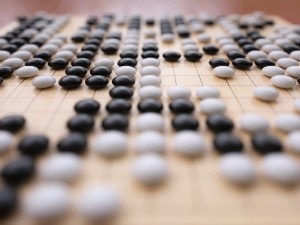Apr 2 2018
In 1996, when a game of chess against Garry Kasparov, the then reigning world chess champion, was won by a computer, it was sensational. Following this advancement in the world of chess, for a very long time, the board game Go was regarded as a stronghold reserved for human players due to its complexity.
 The board game Go was long considered to be a bastion reserved for human players. Nowadays, however, the world’s best players no longer have any chance of winning against the “AlphaGo” software. The recipe for the success of this software can be put to excellent use to plan chemical syntheses, too. (Image credit: fotolia.com/Sergey)
The board game Go was long considered to be a bastion reserved for human players. Nowadays, however, the world’s best players no longer have any chance of winning against the “AlphaGo” software. The recipe for the success of this software can be put to excellent use to plan chemical syntheses, too. (Image credit: fotolia.com/Sergey)
However, at present, even the world’s best players cannot win against the “AlphaGo” software. The success of this computer program is ensured by a recipe including a combination of the well-known Monte Carlo Tree Search and deep neural networks based on artificial intelligence and machine learning. At present, a research team from the University of Münster has shown that this combination is exceptionally well-suited to planning chemical syntheses, or retrosyntheses, with remarkable efficiency. The study has been reported in the latest issue of the Nature journal.
Retrosynthesis is the ultimate discipline in organic chemistry. Chemists need years to master it—just like with chess or Go. In addition to straightforward expertise, you also need a goodly portion of intuition and creativity for it. So far, everyone assumed that computers couldn’t keep up without experts programming in tens of thousands of rules by hand. What we have shown is that the machine can, by itself, learn the rules and their applications from the literature available.
Marwin Segler, Lead Author
Retrosynthesis is the standard technique used for devising the synthesis of chemical compounds. The concept involves going backward mentally and breaking the compound into ever smaller components until obtaining its basic constituents. This investigation provides the “cooking recipe,” which is subsequently used for working “forward” in the lab to synthesize the target molecule, advancing from the starting materials. Although it seems theoretically easy, in practice, the process is highly difficult.
“Just like in chess, in every step or move you’ve got variety of possibilities to choose from,” stated Segler. “In chemistry, however, there are orders of magnitude more possible moves than in chess, and the problem is much more complex.”
The new technique plays a vital role in connecting the deep neural networks with the Monte Carlo Tree Search—a constellation that is very propitious and driving a large number of researchers from a range of disciplines to work on it. The Monte Carlo Tree Search is a technique for evaluating moves in a game. For each move, the computer simulates a number of variants, for instance, how a chess game might end. Then, the most propitious move is selected.
Similarly, the computer searches for the best possible “moves” for the synthesis of chemicals. It even learns by using deep neural networks. In order to achieve this, the computer fetches all the chemical literature published to date, describing nearly 12 million chemical reactions. Mike Preuss, the co-author of the study, who is an information systems specialist, summarizes it in a simplified manner: “The deep neural networks are used for predicting which reactions are possible with a certain molecule. Using the Monte Carlo Tree Search, the computer can test whether the reactions predicted really do lead to the target molecule.”
It is not new to use computers to devise the syntheses. “The idea is actually about 60 years old” stated Segler, “People thought it would be enough, as in the case of chess, to enter a large number of rules into the computer. But that didn’t work. Chemistry is very complex and, in contrast to chess or Go, it can’t be grasped purely logically using simple rules. Added to this is the fact that the number of publications with new reactions doubles every ten years or so. Neither chemists nor programmers can keep up with that. We need the help of an ‘intelligent’ computer.” The new technique is nearly 30 times faster than traditional programs for devising syntheses and it discovers potential synthesis routes for about twice the amount of molecules.
While performing a double-blind AB test, the Münster scientists discovered that chemists regard these computer-devised synthesis routes to be equally good as prevalent tried-and-tested routes. “We hope that, using our method, chemists will not have to try out so much in the lab,” added Segler, “and that as a result, and using fewer resources, they will be able to produce the compounds which make our high standard of living possible.”
The German Research Foundation funded the study as part of Collaborative Research Centre 858, “Synergetic Effects in Chemistry.”